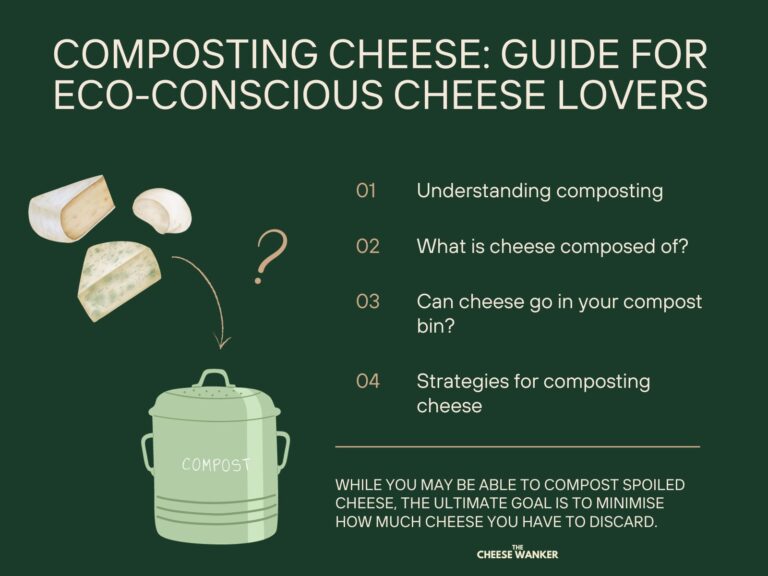You love cheese, right? And I’m sure that you usually eat your cheese as quickly as possible. Having said that, in the off chance that cheese spends time in your fridge, you should know what the signs of spoilage are. In this post, we will discuss the general guidelines for how to tell if cheese has gone bad. And give you tips for what you should do with it.
SEE ALSO: The Cheese Wanker’s complete guide to storing cheese at home →
Why is it important?
Cheese is a perishable food, meaning it can spoil and harbour harmful bacteria. Moreover, consuming spoiled cheese can lead to a number of foodborne illnesses. Some signs of food poisoning include vomiting, diarrhoea and other unpleasant symptoms.
By being able to identify signs of spoilage, you can avoid these health risks and ensure that you’re only consuming safe and delicious cheese.
What are the signs that cheese has gone bad?
Spoiled cheese can have a range of visual indicators, including mould growth, discolouration and a slimy or greasy texture. While the smell of off cheese can vary depending on the type of cheese and the stage of spoilage, it’s often described as rancid, sour or putrid. In terms of taste, off cheese can be bitter, acidic or unpleasantly sour.
Let’s take a closer look at each characteristic and how to tell if cheese has gone bad.
Major discolouration on rind and paste
The colour of cheese can change if it goes bad due to a variety of factors.
Undesirable mould growth
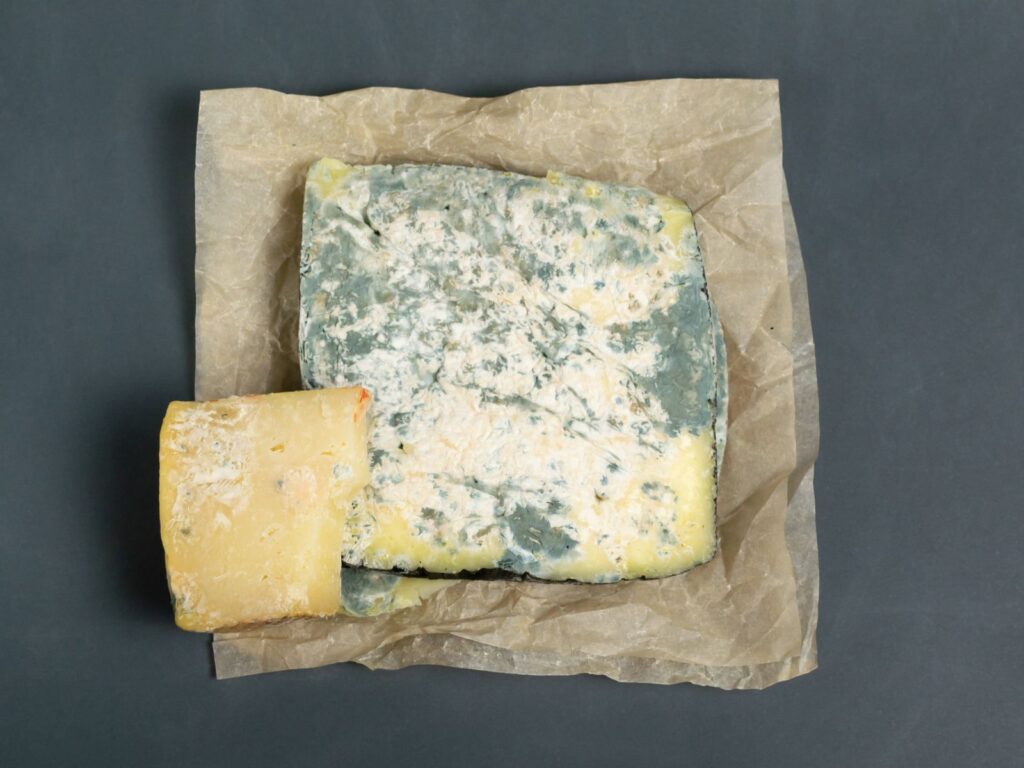
Mould growth on cheese can be both desirable and undesirable. Some types of cheese, such as Stilton or Brie, are intentionally inoculated with moulds to achieve a specific flavour or texture.
As a matter of fact, the cheesemaker carefully controls and monitors the mould to ensure that they do not overgrow and cause the cheese to spoil. In these cases, the mould is desirable and safe to eat.
However, if mould grows on cheese unintentionally or if it is not properly controlled, it may produce spores and toxins that can make the cheese unsafe to eat. Different types of mould can cause different colours and patterns on the cheese, such as blue, red or white spots.
While some moulds on cheese are harmless, others can be toxic and potentially dangerous if consumed in large amounts. It’s important to always check for signs of unsafe mould growth on cheese, such as unusual colours, textures or odours. And you should discard any cheese that appears to be spoiled or contaminated.
You can read more about how to tell good mould from bad mould in our post here.
Light oxidation


Another factor that can affect the colour of cheese is oxidation. This happens because a compound called beta-carotene is broken down during oxidation. Beta-carotene is present in high levels in cow’s milk and is responsible for the yellow colour we associate with most cheeses.
The loss of beta-carotene means that the exposed part of the cheese will lose its yellow colour and look much whiter. Have a play with the slider above to see what difference light can make. This is why it’s important to store cheese properly to prevent it from being over-exposed to light. Actually, we’ve got an entire post that covers this topic here.
Browning during ageing
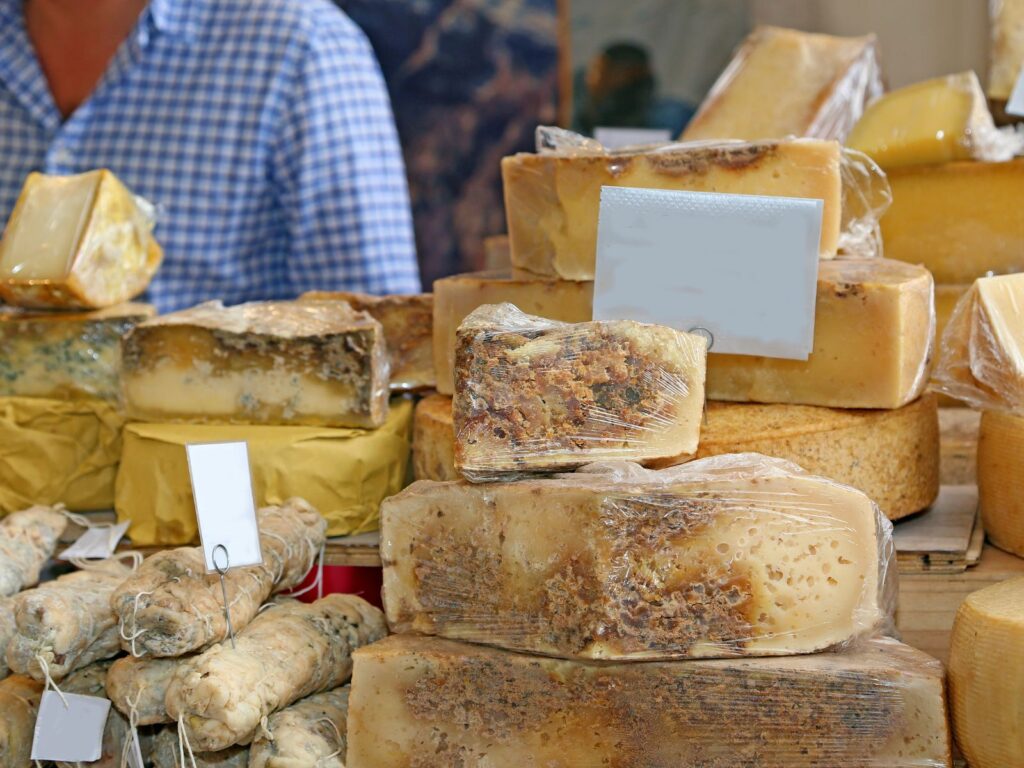
Finally, browning is another sign of spoilage that can appear in cheeses like Gouda and Parmesan. Effectively, browning is the result of a complex reaction between reducing sugars and amino acids from the breakdown of protein in cheese.
This defect is more likely to occur in cheeses that contain thermophilic cultures because of their effect on lactose. This can result in a build-up of sugar, which, when combined with warmer temperatures and lengthy storage, can cause Maillard browning.
In general, any significant colour change in cheese can be a sign that the cheese has spoiled. While this may not necessarily mean that the cheese is not safe to eat, its flavour and texture will definitely be sub-optimal. As always, if unsure, discard.
Significant changes in the cheese’s texture
Furthermore, the texture of cheese can be a good indicator of whether or not it has gone bad. It’s important to note that some changes in texture may be normal for certain types of cheese. However, any sudden or unusual changes in texture can be a sign that the cheese has spoiled.
Hardening or cracking
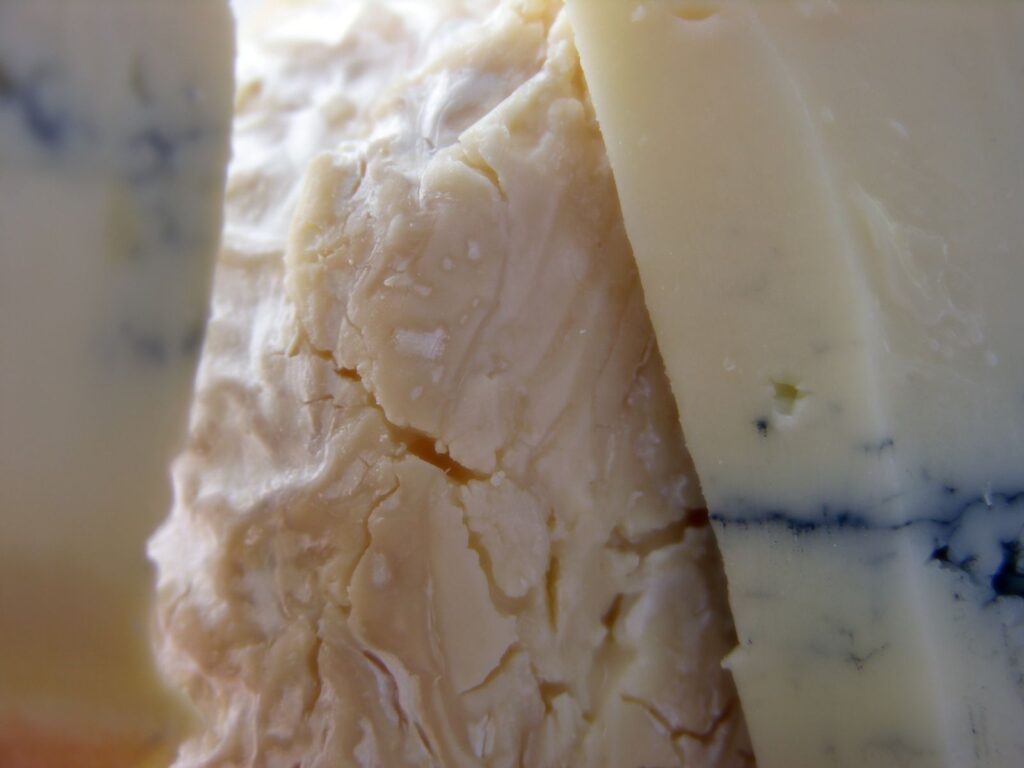
Hard cheeses like Cheddar can start to crack when they spoil due to changes in the cheese’s moisture content and the growth of unwanted bacteria. As hard cheeses age, they lose moisture, which can cause them to become brittle and prone to cracking.
To prevent cracking, it’s important to store your cheese in a cool place with good air circulation. Moreover, the right humidity conditions will reduce the risk of cracking.
Sliminess
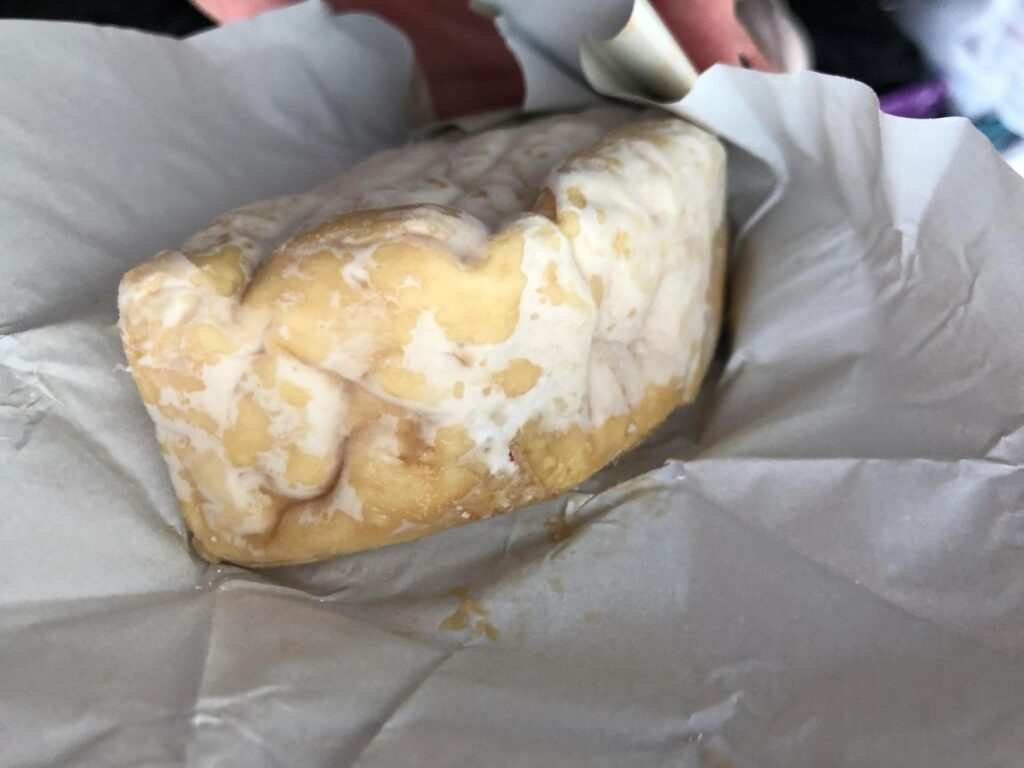
Soft white mould cheeses like Camembert can become slimy when they spoil due to the growth of unwanted bacteria. Camembert cheese is made by adding Penicillium candidum, a type of white mould, to the milk. During the cheesemaking process, the mould grows on the surface of the cheese and helps to create its characteristic bloomy rind.
However, if the cheese is not properly stored, other types of bacteria can grow and cause spoilage. When this happens, the cheese can become slimy and develop an off-putting odour. We’ll get back to the odour a little bit later.
Grittiness on the rind

If cheese starts to develop a gritty or grainy texture, this can also be a sign of spoilage. Actually, this type of spoilage can be particularly obvious in soft washed rind cheeses like Epoisses and Stinking Bishop.
The bacteria on the surface of these cheeses cause deacidification, which leads to the formation of crystals. Washed rind cheeses have all the necessary components for crystal formation, including calcium, phosphate, magnesium, carbonate and ammonium. Indeed, those are all found in milk, cheese and naturally produced by the ageing process. These components combine to create a gritty rind.
Now, it’s important to note that a gritty rind does not necessarily indicate spoilage. But if your cheese’s rind is excessively gritty and also slimy, something has most probably gone wrong. To be safe, we’d recommend that you discard it.
Strong and unpleasant cheese odour
Finally, the smell of cheese can be a good indicator of whether or not it has gone bad. When cheese spoils, it can develop a range of unpleasant odours. In most cases, this is due to the growth of bacteria or the breakdown of proteins and fats in the cheese.
In general, any significant change in the smell of cheese from its normal odour can be a sign that the cheese has gone off and should be avoided. Let’s have a look at some specific examples.
Pungent and acrid (ammonia)
Firstly, ammonia is one of the most common chemicals that can be present in off cheese. It’s produced by bacteria that break down the protein in cheese. And it has a strong, pungent smell that is similar to cleaning products or urine.
Ammonia is more commonly found in aged or blue cheeses, where it can be a natural by-product of the cheesemaking process. However, excessive amounts of ammonia can indicate spoilage. In addition to the unpleasant smell, cheese that has high levels of ammonia can also have a bitter or sour taste.
Rancid and vomit-like (butyric acid)
Next, butyric acid (butanoic acid) is another chemical that can be present in cheese when it goes bad. This short-chain fatty acid is produced by bacteria when they break down the fat in cheese. Notably, butyric acid has a pungent, rancid smell and can give cheese a sour or unpleasant taste.
It’s often associated with soft, creamy cheeses like Brie that have a higher moisture content and are more prone to spoilage. While small amounts of butyric acid can be present in some aged cheeses like Parmesan, excessive amounts can indicate spoilage.
Musty and mouldy (geosmin)
The musty smell in cheeses like Brie de Meaux is primarily caused by a compound called geosmin, which is produced by the bacteria used to ripen the cheese. Geosmin has an earthy aroma, which can be described as a musty, damp or mossy.
It is produced by certain types of bacteria and fungi commonly found in soil. And is also responsible for the earthy smell after rain. In addition to geosmin, other volatile organic compounds produced during the ripening of cheese can contribute to the overall mouldy smell. Some examples include 2-methylpropanal, 2-methylbutanal, and 3-methylbutanal.
Having said that, a subtle earthy smell is normal (and desirable) in most soft white mould cheeses. However, improper storage can lead to excessive geosmin production and the musty smell can quickly become overwhelming.
What should I do with spoiled cheese?
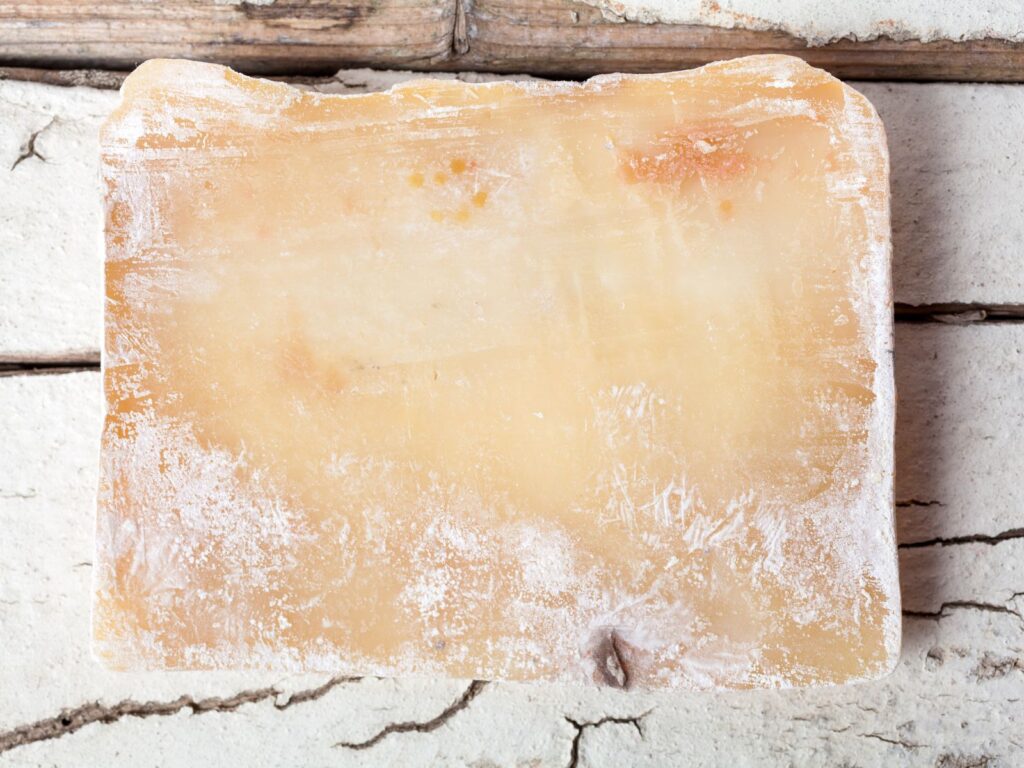
If cheese is showing signs of spoilage, it’s best to discard it. Eating spoiled cheese can make you sick, as it may contain harmful bacteria or toxins that can cause foodborne illness.
However, if you notice only a small amount of mould on a hard cheese, you can try to salvage it by cutting off the affected area (plus a little extra) with a clean knife. The remaining cheese should be safe to eat, as long as it looks and smells okay.
If you have a large amount of spoiled cheese, wrap it in a plastic bag and dispose of it in the garbage bin outside. Alternatively, some cities have food waste recycling programs that accept spoiled cheese, so check if this is an option in your area.
How can I prevent cheese from going off?

Here are 4 great tips to prevent cheese from spoiling:
- Buy the correct amount of cheese: The single most important thing you can do is to only buy an amount of cheese that you can consume within one week. Moreover, use the “Best Before Date” on the cheese as a guide when buying.
- Store cheese properly: Different types of cheese require different storage conditions. Generally, soft cheeses like Brie and Camembert should be stored in the fridge in their original packaging. As for harder cheeses, they can be stored in a sealed container or wrapped in wax paper. You can read our complete cheese storage guide here.
- Consume cheese quickly: Also, you will want to consume your cheese as quickly as possible. This is particularly important once you have cut into soft cheeses (72 hours at most). On the other hand, hard cheeses can last longer, but even they should be used within a week of being opened.
- Handle cheese properly: When cutting cheese, make sure to use clean utensils and always wash your hands thoroughly. Dirty knives and hands can introduce bacteria to the cheese and cause it to spoil more quickly. Also, try to cut only what you need and leave the rest of the cheese intact.
Summary: Discard if unsure
In summary, knowing how to tell if cheese has gone bad is crucial for your health and safety. If you’ve had cheese in your fridge for a few days, check for changes in appearance, smell and texture before you eat it.
If in doubt, it’s always better to err on the side of caution and discard any cheese that you suspect has gone off. By following these guidelines, you can ensure that you’re only consuming delicious and safe cheese.
Do you have any tips for avoiding cheese waste? Drop us a comment below.
